Introduction
Iceland captivates visitors year-round with its dramatic landscapes that transform with each passing season. This Nordic wonderland offers an enchanting mix of geothermal wonders, cascading waterfalls, majestic glaciers, and otherworldly terrains that seem plucked from fantasy. Whether you’re chasing the ethereal Northern Lights or basking in the midnight sun, timing your visit is crucial to experiencing the Iceland of your dreams.
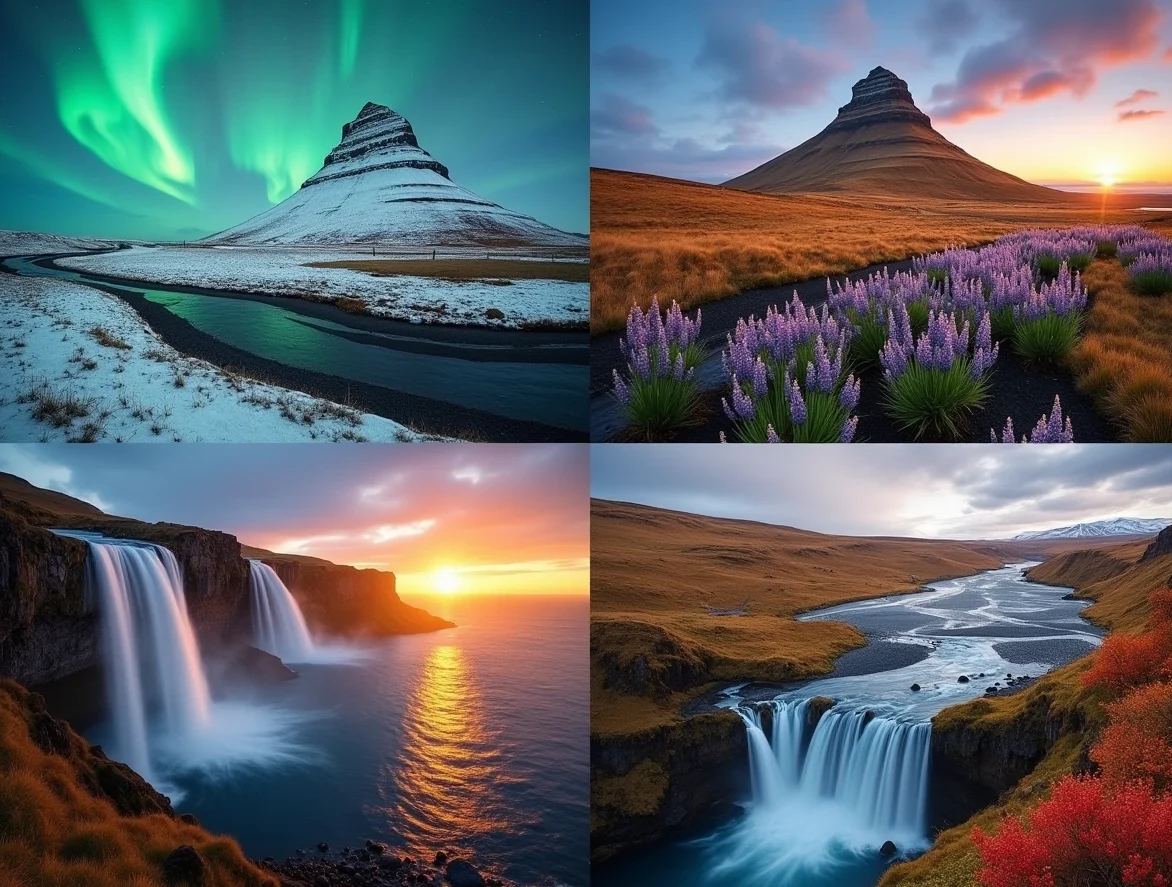
Iconic attractions like the mesmerizing Northern Lights, rejuvenating Blue Lagoon, and the spectacular Golden Circle route attract travelers throughout the year—yet each experience varies dramatically depending on when you choose to visit. This comprehensive guide will help you determine the perfect time for your Icelandic adventure based on weather conditions, daylight hours, activities, and budget considerations.
For tailored itineraries, exclusive deals, and expert travel planning assistance, explore Travrazone.com. We’ve also compiled essential information on finding the best flights to Iceland, securing ideal accommodations across the island, and selecting appropriate travel insurance for your Nordic adventure.
Why Timing Matters for Visiting Iceland
How Seasons Affect Travel Experiences
Iceland’s distinct seasons create dramatically different travel experiences that can transform your vacation. Winter’s snow-blanketed landscapes provide the perfect canvas for the dancing Northern Lights, while summer’s perpetual daylight lets you pack in round-the-clock adventures. Understanding these seasonal variations is essential for aligning your visit with your travel priorities and expectations.
Find the best flights and hotels deals iceland from USA
Key Things to Consider: Weather, Daylight, Crowds, and Costs
- Weather: Iceland’s temperatures range from mild summers (10-15°C/50-59°F) to cold winters (-5 to 5°C/23-41°F), with frequent wind and precipitation that can change rapidly throughout the day.
- Daylight Hours: The contrast is striking—summer solstice brings nearly 24 hours of functional daylight, while winter solstice offers just 4-5 hours, fundamentally changing what you can accomplish each day.
- Tourist Density: Peak summer months (June-August) bring significantly larger crowds to popular attractions, while winter visitors often enjoy more solitary experiences.
- Travel Costs: Accommodation and tour prices can increase by 50-100% during the high summer season compared to winter and shoulder season rates.
Iceland by Season: What to Expect
Winter (Dec–Feb): Best for Northern Lights, Ice Caves, Snowy Landscapes
Winter transforms Iceland into a mesmerizing snow-covered realm where darkness prevails but brings magical rewards. The limited daylight (4-6 hours) creates perfect conditions for hunting the elusive Northern Lights as they dance across star-filled skies. The season unveils unique experiences like exploring naturally formed blue ice caves beneath massive glaciers and soaking in geothermal hot springs surrounded by snow.
Winter Highlights:
- Prime Northern Lights viewing opportunities
- Exclusive access to natural ice caves
- Enchanting Christmas and New Year celebrations
- Dramatically lower prices and fewer tourists
- Stunning contrast of white snow against black lava fields
Winter Challenges:
- Limited daylight restricts sightseeing hours
- Unpredictable weather and road closures
- Many highland roads become completely inaccessible

Spring (Mar–May): Waterfalls at Peak, Fewer Crowds, Migratory Birds Return
Spring represents Iceland’s awakening, with gradually increasing daylight and temperatures. Melting snow transforms the country’s numerous waterfalls into thunderous spectacles—Gullfoss, Skógafoss, and Dettifoss reach peak impressive power. Wildlife enthusiasts cherish the return of puffins and other migratory birds to coastal cliffs. This shoulder season strikes an excellent balance between increasingly stable weather and manageable crowd levels.
Spring Highlights:
- Waterfalls reach maximum volume and power
- Puffins return to coastal cliffs (late April)
- Growing daylight hours (10-20 hours through the season)
- First highland flowers begin blooming
- Substantially smaller crowds than summer months
Summer (Jun–Aug): Midnight Sun, Road Trips, Festivals, Whale Watching
Summer remains Iceland’s most popular season—and for good reason. The midnight sun phenomenon provides almost continuous daylight, allowing for packed itineraries and spontaneous midnight adventures. All roads become accessible, including the highland F-roads that lead to the colorful rhyolite mountains of Landmannalaugar and other interior treasures. The season buzzes with cultural events showcasing Icelandic music, arts, and traditions.
Summer Highlights:
- Nearly 24-hour daylight for maximized exploration
- Complete access to highland regions and remote areas
- Lush green landscapes and blooming lupines
- Peak whale watching season with multiple species
- Vibrant festival calendar across the country
- Warmest temperatures of the year (though still cool by most standards)
Autumn (Sep–Nov): Colorful Foliage, Northern Lights Return, Fewer Tourists
Autumn offers a magical combination: summer crowds dissipate while weather remains relatively mild. The landscape transforms with golden and rusty hues as vegetation changes color, creating a photographer’s paradise. Northern Lights begin reappearing in late September when skies grow dark enough. Fall also brings harvest festivals and the internationally acclaimed Iceland Airwaves music festival in Reykjavík.
Autumn Highlights:
- Stunning fall foliage creates colorful landscapes
- Northern Lights visibility returns with darker skies
- Significantly reduced tourist numbers at major attractions
- Moderating prices across accommodations and tours
- Mushroom and berry picking opportunities
Month-by-Month Travel Guide
January
- Weather: Average -3°C to 2°C (27-36°F), frequent snow and wind
- Daylight: 4-6 hours
- Best For: Northern Lights hunting, ice cave exploration, winter photography
- Events: Dark Music Days Festival, Winter Lights Festival (late month)
February
- Weather: Average -3°C to 2°C (27-36°F), continued winter conditions
- Daylight: 7-10 hours
- Best For: Northern Lights, ice caves, Winter Lights Festival
- Events: Winter Lights Festival, Food and Fun Festival, Valentine’s Day special tours
March
- Weather: Average -2°C to 3°C (28-37°F), beginning transition to spring
- Daylight: 10-13 hours
- Best For: Northern Lights with increasing daylight, final ice cave tours
- Events: DesignMarch, Beer Festival, Iceland Winter Games
April
- Weather: Average 1°C to 7°C (34-45°F), unpredictable mix of winter and spring
- Daylight: 13-16 hours
- Best For: Puffin watching begins, spring lamb season, waterfall viewing
- Events: First Day of Summer (late April), Easter celebrations
May
- Weather: Average 4°C to 10°C (39-50°F), spring conditions
- Daylight: 16-20 hours
- Best For: Waterfalls at peak flow, spring landscapes, early highland access
- Events: Reykjavík Arts Festival, Vaka Folk Festival
June
- Weather: Average 7°C to 12°C (45-54°F), mild and pleasant
- Daylight: 20-24 hours (midnight sun)
- Best For: Highland exploration, white water rafting, midnight sun experiences
- Events: Secret Solstice Festival, Viking Festival, National Day (June 17), Midnight Sun Run
July
- Weather: Average 8°C to 14°C (46-57°F), warmest month
- Daylight: 19-22 hours
- Best For: Hiking, camping, complete Ring Road trips, whale watching
- Events: Landsmót (Horse Festival), Folk Music Festival, Bræðslan Music Festival
August
- Weather: Average 7°C to 13°C (45-55°F), mild
- Daylight: 16-19 hours
- Best For: Berry picking, outdoor activities, more comfortable temperatures
- Events: Reykjavík Pride, Culture Night, Reykjavík Marathon, Jökulsárlón Fireworks
September
- Weather: Average 5°C to 10°C (41-50°F), autumn begins
- Daylight: 13-16 hours
- Best For: Fall colors, beginning of Northern Lights, photography
- Events: Réttir (sheep roundup), Reykjavík International Film Festival
October
- Weather: Average 2°C to 7°C (36-45°F), increasing precipitation
- Daylight: 9-12 hours
- Best For: Northern Lights, fall landscapes, hot spring bathing
- Events: Iceland Airwaves Music Festival, Halloween events
November
- Weather: Average 0°C to 5°C (32-41°F), wintery conditions begin
- Daylight: 6-9 hours
- Best For: Northern Lights, hot springs, early winter activities
- Events: Iceland Noir (crime fiction festival), Northern Lights Festival
December
- Weather: Average -3°C to 2°C (27-36°F), full winter conditions
- Daylight: 4-5 hours
- Best For: Christmas traditions, Northern Lights, New Year’s Eve celebrations
- Events: Christmas markets, Yule Lads appearances, New Year’s Eve fireworks
Best Time to See the Northern Lights in Iceland
When and Where to Go for Optimal Aurora Viewing
The Northern Lights (Aurora Borealis) are visible in Iceland from late August through early April, with peak visibility occurring during the darkest months. For optimal viewing experiences:
- Prime Months: September-October and February-March offer the best combination of darkness and typically more stable weather
- Viewing Hours: Between 9 PM and 2 AM on clear, dark nights
- Best Locations:
- Þingvellir National Park (accessible from Reykjavík)
- Jökulsárlón Glacier Lagoon (dramatic reflections on the water)
- Kirkjufell Mountain (iconic foreground for photography)
- Reykjanes Peninsula (low light pollution, convenient from airport)
- Ásbyrgi Canyon (excellent dark sky area in North Iceland)
For a successful aurora hunt, monitor the Icelandic Met Office aurora forecast daily and check cloud cover predictions. Consider booking a guided Northern Lights tour with local experts who track conditions nightly and know secluded viewing locations away from city lights.
Best Time for Budget Travel
Cheapest Months to Visit
For travelers seeking to maximize value without compromising experience, strategic timing is essential:
- Absolute Lowest Prices: November (excluding Thanksgiving week) and January through mid-March
- Best Value Periods: April-May and September-October offer reasonable prices with improved weather and daylight conditions
- Price Differentials: Hotel rates can be 40-60% lower during winter compared to peak summer
How to Save Money on Flights, Hotels, and Tours
- Flights: Book 2-3 months in advance for winter travel and 4-6 months for summer; midweek departures typically offer lower fares
- Accommodations: Consider guesthouses, hostels, and farm stays; book winter accommodations last-minute for potential discounts
- Transportation: Share rental cars with fellow travelers through carpooling services; utilize public transportation in Reykjavík
- Food: Shop at budget supermarkets like Bónus and Krónan; bring a reusable water bottle (tap water is excellent quality)
- Attractions: Purchase the Reykjavík City Card for included attractions and transportation; visit natural sites (most are free)
- Tours: Book shoulder season packages with combined activities for better rates; look for early booking discounts
Best Things to Do in Iceland
Iceland offers extraordinary experiences throughout the year. Here are some must-do activities with the best times to enjoy them:
Blue Lagoon: Admission Package with Drink, Towel, and Mask
The iconic Blue Lagoon offers a rejuvenating geothermal spa experience amid a dramatic lava field. The standard admission package includes entrance to the milky-blue waters, a silica mud mask, one drink of your choice, and a towel rental.
Best Time: For a magical experience, visit during early morning (opening time) or evening hours for fewer crowds. Winter visitors can enjoy the surreal contrast of snow, steam, and blue waters, while summer offers midnight sun bathing opportunities.
Why Visit: The mineral-rich waters maintain a constant 38°C (100°F) temperature year-round and are known for their healing properties, particularly for skin conditions.
Check availability and book your Blue Lagoon experience
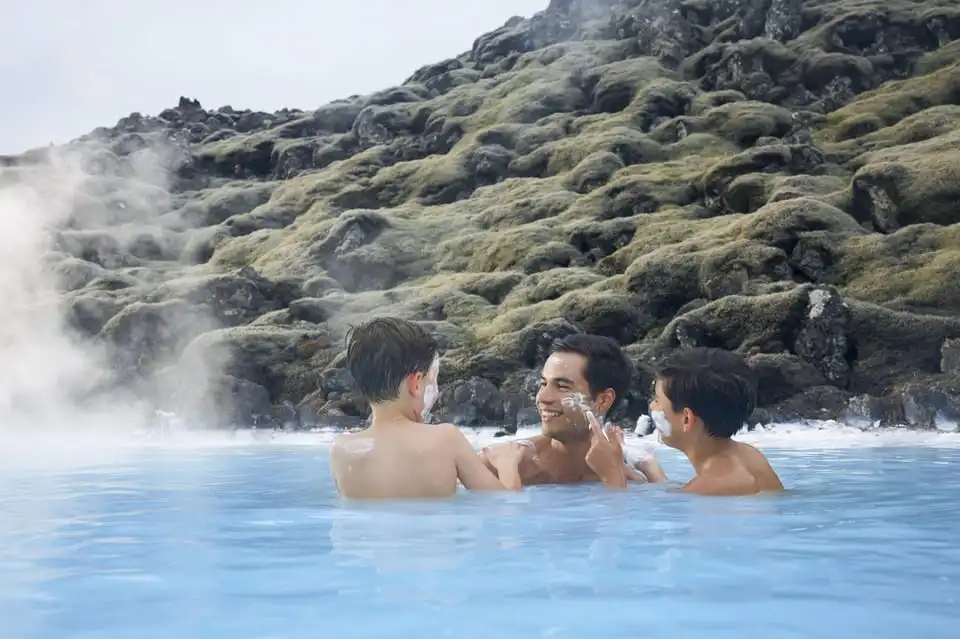
Jökulsárlón: The Original Ice Cave Tour on Vatnajökull
Explore crystal blue ice caves beneath Europe’s largest glacier on this breathtaking tour. Expert guides lead you through naturally formed caves that change each year, creating a truly unique experience.
Best Time: Ice caves are only accessible from mid-November through March when temperatures are cold enough to ensure structural stability.
Why Visit: These ephemeral natural wonders feature stunning blue ice formations, created when centuries-old compressed glacier ice meets filtered light. The caves offer unparalleled photography opportunities and a glimpse into glacial processes.
Secure your ice cave adventure

Varmahlid: 1-Hour Icelandic Horse Riding Tour
Experience Iceland’s unique landscape from horseback on gentle, friendly Icelandic horses known for their special fifth gait called “tölt.” This tour accommodates all experience levels, from beginners to advanced riders.
Best Time: May through September offers the most comfortable riding conditions with greener landscapes, though tours operate year-round.
Why Visit: Icelandic horses are a special breed maintained in isolation for over 1,000 years, known for their intelligence, sure-footedness, and smooth gaits. This tour provides an authentic connection to Icelandic culture and countryside.
Book your horseback riding adventure
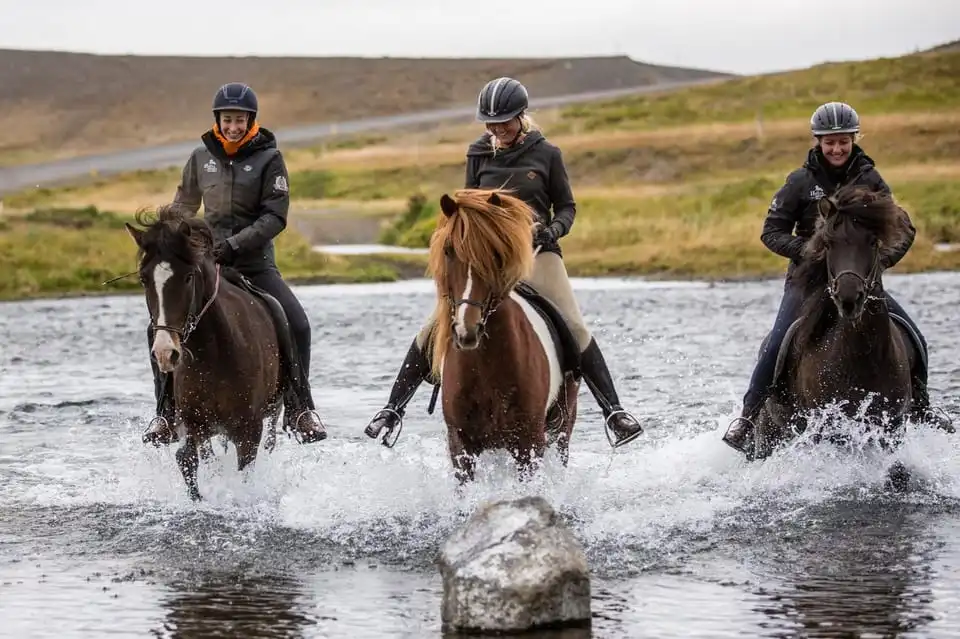
Mývatn: Myvatn Nature Baths Admission Ticket
Often called “the Blue Lagoon of the North,” the Mývatn Nature Baths offer a more relaxed, less crowded geothermal bathing experience with stunning views over Lake Mývatn and surrounding volcanic landscapes.
Best Time: Visit during shoulder seasons (May-June or September-October) for fewer crowds. Winter visits offer potential Northern Lights viewing while bathing.
Why Visit: These alkaline baths are rich in minerals that soothe skin and muscles. The remote North Iceland location provides a more authentic, less commercial experience than more famous geothermal spas.
Reserve your Mývatn Nature Baths experience
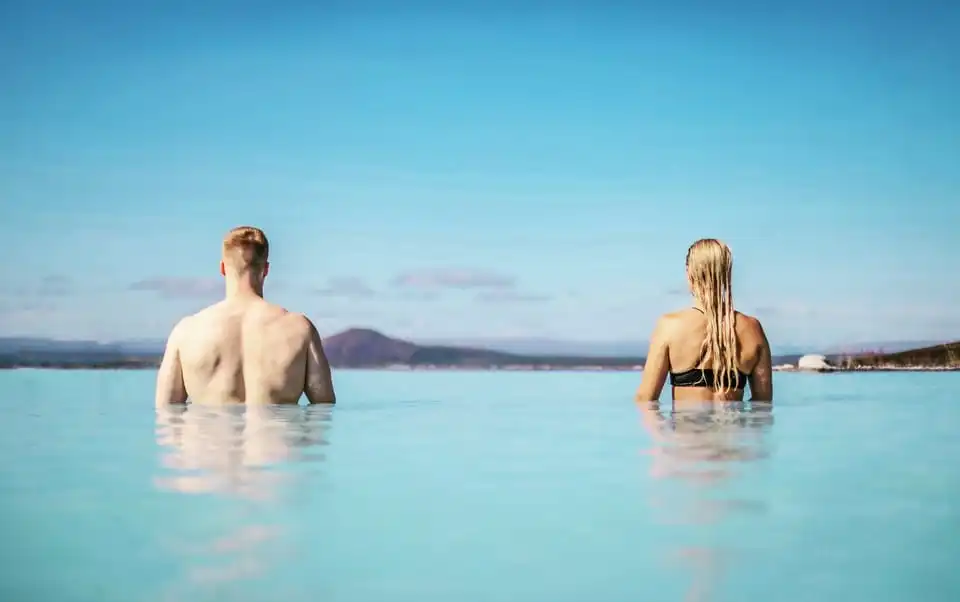
Reykjavík: Whale Watching and Marine Life Cruise
Set sail from Reykjavík’s Old Harbor in search of minke whales, white-beaked dolphins, harbor porpoises, and occasionally humpback whales. Modern vessels with viewing platforms and indoor heated areas ensure comfort in all conditions.
Best Time: The prime whale watching season runs from April through October, with June-August offering the highest success rates and more species diversity.
Why Visit: Iceland’s nutrient-rich coastal waters attract diverse marine life. Knowledgeable guides provide insights about the marine ecosystem and conservation efforts. Many tours offer a “whale guarantee” – if no whales are spotted, you can join another tour for free.
Check whale watching availability

Reykjavik: Golden Circle Full-Day Tour with Kerid Crater
This comprehensive tour covers Iceland’s famous Golden Circle route plus the stunning Kerid volcanic crater. Highlights include the geothermal wonders of Geysir, the powerful Gullfoss waterfall, and historic Þingvellir National Park where the North American and Eurasian tectonic plates visibly separate.
Best Time: This tour operates year-round, with each season offering distinct advantages. Summer provides lush landscapes and easier walking conditions, while winter offers snow-covered scenery and potential Northern Lights on late afternoon tours.
Why Visit: The Golden Circle showcases Iceland’s most iconic natural wonders within a convenient day trip from Reykjavík. The addition of Kerid Crater with its aquamarine lake within a red volcanic caldera provides a stunning photographic opportunity not included in standard Golden Circle tours.
Book your Golden Circle adventure

Best Time for Specific Activities
Whale Watching
Prime whale watching season runs from April through October. June through August offers the highest success rates for spotting multiple species including minke whales, humpbacks, white-beaked dolphins, and harbor porpoises. Húsavík in North Iceland holds the title of “Whale Watching Capital of Europe,” though excellent tours operate from Reykjavík, Akureyri, and Dalvík as well.
Ice Cave Exploration
Natural ice caves are only accessible from mid-November through March when temperatures stabilize glacial structures. The crystal blue caves beneath Vatnajökull glacier offer the most spectacular formations, while smaller caves near Mýrdalsjökull provide easier access from Reykjavík. Guided tours are mandatory for safety reasons as caves can collapse or flood quickly.
Hiking and Camping
The optimal hiking window spans from June through early September when mountain trails are snow-free and facilities are open. July offers ideal conditions with maximum daylight and warmer temperatures, though also peak crowds. The Laugavegur Trail connecting Landmannalaugar to Þórsmörk ranks among the world’s great treks, while day hikes in Skaftafell and Þórsmörk offer more accessible options.
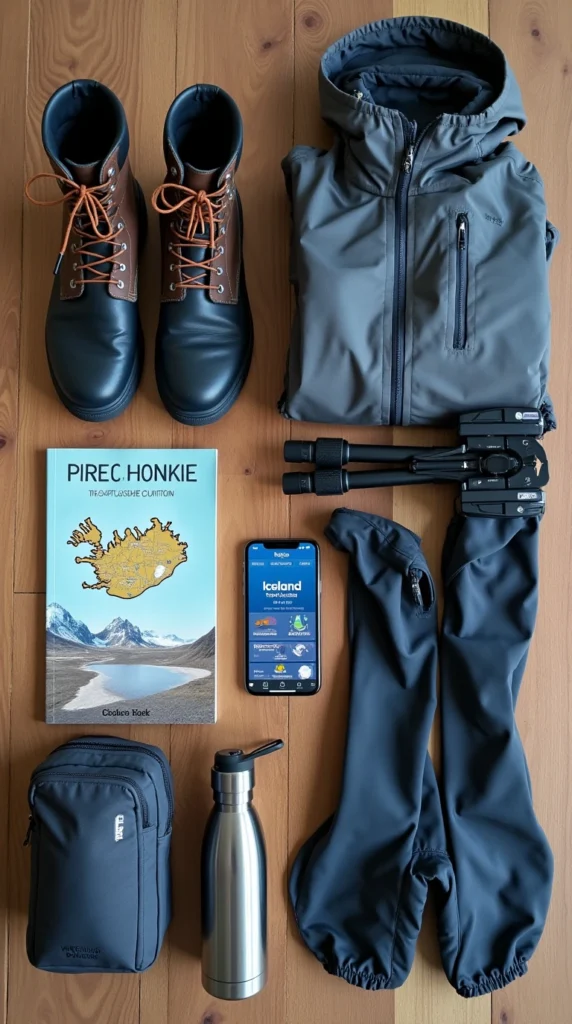
Photography: Ice Cave Captured with Professional Photos
Your photographer and glacier guide will lead you to one of Iceland’s most scenic glaciers. As you immerse yourself in the blue ice, your guide will capture the special moments of your tour.
Each season offers unique photographic opportunities:
- Winter: Northern Lights, ice formations, snow-covered landscapes, dramatic low light
- Spring: Waterfalls at maximum power, emerging greenery, returning wildlife, fewer people in shots
- Summer: Midnight sun with golden hour lighting lasting for hours, accessible highlands, lush landscapes
- Fall: Dramatic skies, autumn colors, early auroras with reflections, moody atmospheric conditions

Final Tips for Planning Your Trip
What to Pack by Season
Winter (Nov-Mar):
- Insulated waterproof jacket and pants
- Multiple thermal base layers (merino wool recommended)
- Waterproof hiking boots with excellent traction
- Insulated hat, waterproof gloves, wool socks, neck gaiter
- Swimsuit for hot springs (essential year-round in Iceland)
- Crampons or ice grips for shoes
- Hand/foot warmers for extended outdoor activities
Summer (May-Sep):
- Waterproof jacket and pants (regardless of season)
- Layering options for variable temperatures
- Sturdy hiking boots with ankle support
- Sunglasses and eye mask for sleeping during midnight sun
- Light gloves and hat (even in summer)
- Insect repellent (for certain areas like Mývatn)
Spring/Fall:
- Focus on versatile layering options
- Both warm and waterproof outer layers
- Sturdy footwear for potentially muddy conditions
- Packable down jacket for quickly dropping temperatures
Travel Insurance & Weather Prep
Iceland’s remote location and unpredictable conditions make comprehensive travel insurance essential. Look for policies covering:
- Trip cancellation due to severe weather conditions
- Emergency medical evacuation from remote areas
- Rental car protection with gravel road coverage
- Activity coverage for adventure sports
Before heading out each day, check real-time conditions at road.is (road conditions) and vedur.is (weather forecasts). The SafeTravel.is website allows you to register your travel plans with Icelandic search and rescue teams—a critical safety step for any travel beyond urban areas, especially in winter.
Download the 112 Iceland emergency app, which allows one-touch location sharing with emergency services if you encounter trouble in remote areas.
FAQs
What is the best time to travel to Iceland?
The best time depends entirely on your priorities. June-August offers optimal weather and endless daylight but comes with peak crowds and prices. February-March and September-October provide excellent Northern Lights viewing with fewer tourists. May and September offer the best overall balance between reasonable weather, moderate crowds, and good value.
Best Hotels in Iceland
Iceland accommodations range from luxury properties to budget-friendly guesthouses. In Reykjavík, consider Hotel Borg for historic luxury or Kex Hostel for stylish budget lodging. Near the Golden Circle, ION Adventure Hotel offers sustainable luxury with geothermal hot springs. Along the South Coast, Fosshotel Glacier Lagoon provides dramatic glacier views, while Hotel Rangá in the south features outdoor hot tubs perfect for Northern Lights viewing.
The Best Hotels in Iceland
For unforgettable luxury experiences, The Retreat at Blue Lagoon offers private lagoon access and world-class dining. Deplar Farm in North Iceland provides ultra-luxury with heli-skiing options in winter and salmon fishing in summer. Torfhús Retreat in the Golden Circle region offers private geothermal basalt hot pots outside traditional turf houses. In East Iceland, Silfurberg features stunning fjord views and farm-to-table dining.
Travel Insurance Iceland
When selecting travel insurance for Iceland, prioritize coverage for weather disruptions, medical evacuation, and adventure activities. Companies like World Nomads and SafetyWing offer specific coverage for Iceland’s unique adventure activities. Ensure your policy includes protection against volcanic ash disruption and coverage for self-drive accidents, as Iceland’s gravel roads and weather pose unique driving challenges.
Get The Best Compare Cheap Travel Insurance
Conclusion
There truly is no “bad” time to visit Iceland—each season unveils different natural wonders and distinct experiences. Winter brings magical Northern Lights and blue ice caves; spring delivers roaring waterfalls and returning wildlife; summer provides endless daylight for maximized exploration; autumn offers colorful landscapes and the return of aurora season with fewer crowds.
The key to an unforgettable Icelandic adventure lies in matching your visit with your personal travel priorities, whether focused on specific activities, budget considerations, or weather preferences. Whatever season you choose, Iceland’s dramatic landscapes will leave an indelible impression on your travel memories.
👉 Visit Travrazone.com for detailed itineraries, exclusive deals, and comprehensive Iceland travel planning tips tailored to your preferred travel season.











